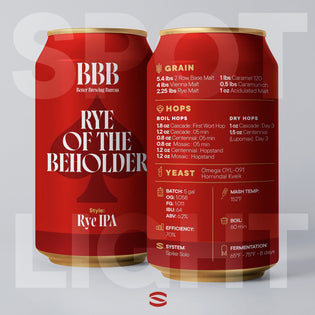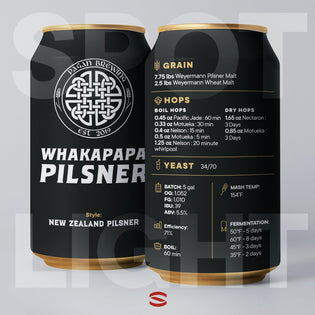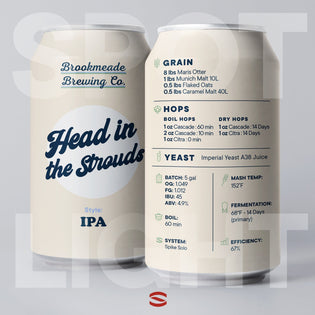The Brewer: Irie Beer Company
I brewed my first batch of beer late October 2018. Less than three years later, I took over as head brewer of Ellipsis Brewing in Orlando, Florida.
I still brew at home about two times a month with my Spike gear (even though I am now brewing 10 bbl batches at work) to keep up with the homebrew brand I built called Irie Beer Company.
I just love to brew and be creative with new hop combos and perfecting various styles of beer!
Needless to say, I am extremely fortunate to be living every homebrewer’s dream.
The Beer: Hazy IPA
I picked this name because not only is it the hop name, but also, since I do usually name my beers after a song title, this worked since it is a song from Pink Floyd’s Dark Side Of The Moon album.
Eclipse hops give off lots of piney and dank notes with some tropical fruit. This beer won Gold at the Sunshine Challenge 2021 competition in Orlando, Florida.

The Recipe: Eclipse

INGREDIENTS
GRAIN
- 12 lbs - 2 row or pale malt
- 2 lbs Flaked oats
- 3.5 lbs Red Wheat
- 1.5 lbs Corn Sugar @ 15 mins.
HOPS
- Boil hops: 1 oz Eclipse - 0:10 min
- Boil hops: 7 oz Cascade - 0:15 min
- Whirlpool @ 170 ºF / 25 minutes
- Dry Hops: 8 oz Eclipse - 2 days
YEAST
- Imperial Yeast – JUICE

INSTRUCTIONS
BATCH SIZE: 6 gal
OG: 16.9 Plato
FG: 2.6 Plato
IBU: 54
ABV: 8%
EFFICIENCY: 70%
MASH TEMP: 156 ºF
BOIL: 30 min
FERMENTATION: 67ºF - 7 days
SYSTEM: SPIKE 20 – BIAB / Spike Flex

Recipe Breakdown
- Mash for 60 minutes
- Target a 2:1 calcium chloride to sulfate ratio for your mash water additions
- Add yeast nutrient at 15 minutes. I use 5 grams.
- Oxygenate your wort prior to pitching yeast. If you do not use oxygen, then remember to shake your fermenter vigorously.
- Dry hop at terminal gravity once fermentation activity is finished.
- Only use the corn sugar if you want to increase your ABV by a few points.
Spike Summarizes: All Things Hazy IPA
What is a Hazy IPA?
Hazy IPAs are by far one of the most popular beers—and we definitely know why. With a “hazy” glow, intense hop aroma and smooth, creamy texture, it’s a true delight for the senses.
Unlike traditional IPAs, Hazy IPAs are brewed with a combination of malts, hops, and yeast that produce a beer with a thick, cloudy appearance and a soft, velvety mouthfeel. These beers have a juicy, fruity flavor and aroma, with notes of citrus, tropical fruits, and stone fruits.
What is the History of a Hazy IPA?
The origins of hazy IPA can be traced back to a brewery in Vermont called The Alchemist. This brewery was founded in 2003 by John and Jen Kimmich and in 2011, They released their first hazy IPA, called Heady Topper.
This beer quickly became a cult classic, and helped to popularize the style of beer that we know today as the Hazy IPA.
What Is the Difference Between a Hazy IPA and a Regular IPA?
Ingredients: Both Hazy and regular IPAs are brewed with a combination of malts, hops, and yeasts. Although hops used in hazy IPAs are usually added late in the brewing process to create a fruitier aroma while in regular IPAs, hops are added early in the brewing process to create a more bitter flavor.
Taste and texture: Hazy IPAs are usually fruitier and less bitter than regular IPAs. Hazy IPAs also have a softer mouthfeel and more rounded flavor profile while regular IPAs have a strong and pronounced hop flavor.
Alcohol content: Hazy IPAs tend to have higher alcohol content than the regular ones. Hazy IPAs typically range from 6-8% alcohol by volume (ABV), while regular IPAs usually range from 4-7% ABV.
Brewing process: in order to give it a unique flavor and aroma, Hazy IPAs are brewed using a variety of techniques versus regular IPAs which are brewed using traditional methods.
What Causes the Haze in Hazy IPAs?
Filtration: Filtration is an important part of the brewing process that removes particles and impurities from the beer, but it’s not necessary. For Hazy IPAs, the filtration process is either skipped or done at a minimal level to keep the beer hazy.
Dry Hopping: If you can smell and taste a strong hop aroma and flavor in your beer, it probably went through dry hopping. This process involves adding hops after the beer has finished fermenting, usually in the form of pellets, cones, or plugs.
Yeast Strains: Yeast strains can be categorized into two main groups: ale yeasts, which are top-fermenting, and lager yeasts, which are bottom-fermenting.
More Grains: The haze that can be seen in wheat beers is mainly because of the wheat itself. This type of grain has a much higher protein content than barley. That being said, Hazy IPAs make use of grains like wheat and oats, which provide a high level of protein that contribute to the beer's cloudy appearance.
What Are the Hops Used in a Hazy IPA?
Aroma Hops: From the name itself, aroma hops impart unique flavors and aroma to the beer. They are typically low in alpha acids which means that they do not contribute much to the beer’s bitterness.
Bittering Hops: To add bitterness to the beer, clearly you need bittering hops. They are typically added during the boil stage of the brewing process, and unlike aroma hops, bittering hops are typically high in alpha acids, which are responsible for the bitter flavor.
Dual-Purpose Hops: When you combine the powers of aroma and bittering hops, you get a dual-purpose hop. It’s the most versatile type of hop as it provides both bittering and aromatics.
Is a Hazy IPA Strong?
Hazy IPAs can range from a light session beer to a full-bodied double IPA. The alcohol by volume (ABV) of a typical Hazy IPA can range from 4-10%. The higher the ABV, the stronger the beer.
What Is the Difference Between a Hazy Pale Ale and an IPA?
Hazy Pale Ales and IPAs both use the same type of malts and hops. The difference is that IPAs are more hop-forward, have a higher ABV, and are more bitter than Pale Ales which are more balanced and have a lighter body.
Why Are Hazy IPAs Expensive?
Hazy IPAs are more expensive due to the cost of ingredients and the labor-intensive process of brewing. The making of a Hazy IPA requires more hops and yeast, which can be expensive and on top of that the brewing process takes longer, so brewers need to charge more to cover their costs.
What Does a Hazy IPA Taste Like?
Hazy IPAs are usually fruity and juicy, with notes of citrus, tropical fruits, and pine. The beer has a creamy texture and a smooth finish. It has a low to moderate bitterness and a moderate to high hop aroma.
Why Is It Called Hazy IPA?
Hazy IPA got its name from its look. The beer is unfiltered and has a hazy, cloudy appearance. This is due to the yeast, proteins, and hops that are suspended in the beer.
Is a Hazy IPA Sweet?
Hazy IPAs are not overly sweet. They have a moderate to high hop aroma, which gives the beer a slight sweetness. However, the bitterness of the hops balances out the sweetness, making the beer more balanced.
Is a Hazy IPA a bitter beer?
What makes a bitter beer? It's all about the hops. Hazy IPAs usually have a low to moderate bitterness. The hop aroma is usually more pronounced than the bitterness, giving the beer a fruity and juicy flavor.
What Is the Alcohol Content of a Hazy IPA?
The alcohol content of Hazy IPAs can range from 4-10% ABV, depending on the type of beer.






